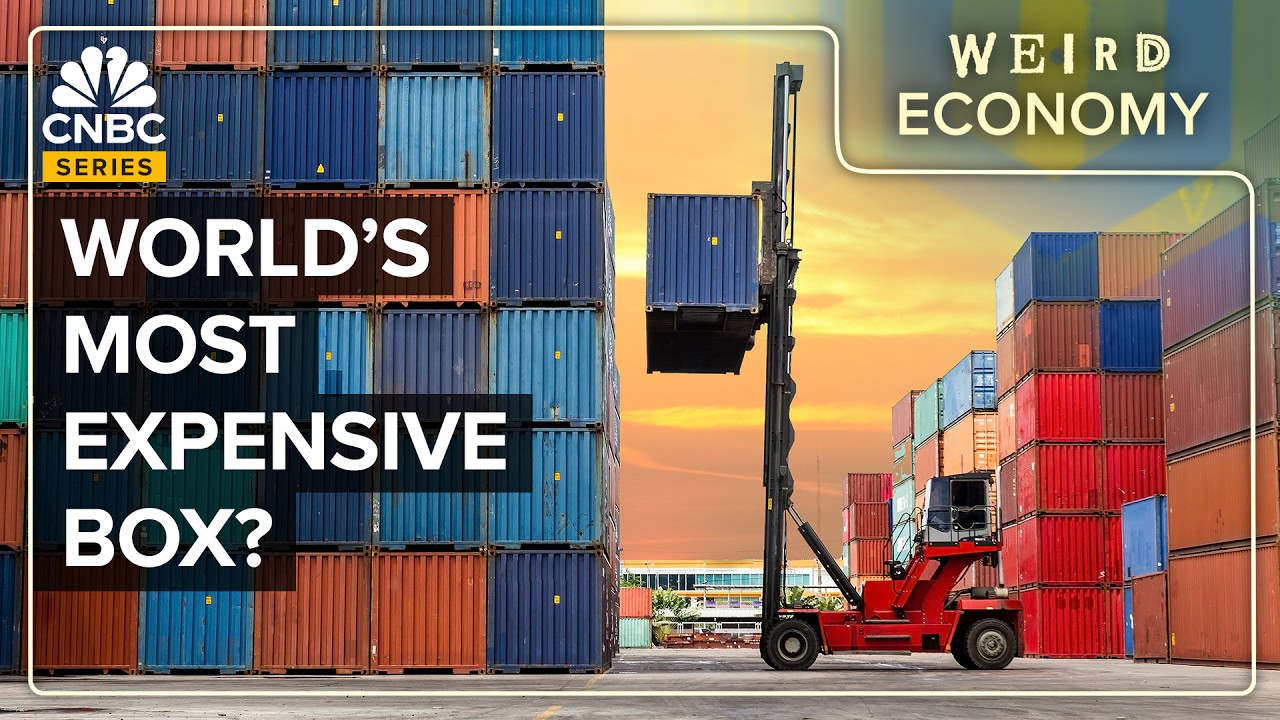Container shipping is
responsible for moving 90% Of the world's goods. Most of it is in metal
boxes like these. You can have hundreds of
items from hundreds of Different companies in
one container. And so it really is a
logistics marvel. But if shipping containers
aren't in the right place At the right time,
problems may unfold. Those containers would
normally be off in 1 to 2 Days, but it's been a
week and they're still Here. Crops that are going to
waste. The supply chain is not
there. You know. It's just not. Congestion at the ports. It limits the
availability of those Coveted containers. It then inflates the
pricing. All of this is Indeed being passed over
to the consumers. People suddenly realize
how important that Container it is to
everybody's standard of Living, really to be
honest with you. By my calculations, if you
take the value of Everything that moves in
container shipping, it Works out to $937 per
year per person on the Planet. Shipping containers
support the flow of global Trade. We are kind of the hidden
secret in the background That tries to make sure
that everything is Everywhere available. Just as China leads the
world in exports, it also Leads in container
manufacturing. One way or another, half
the world's merchant
Marine fleet owes its
existence to China. Here's how shipping
containers can save or Cripple the global
economy. Supply chain disruptions
can have big ramifications For American shoppers and
have a major impact on Inflation. They have
contributed, on average, About 60% of the run up
of US inflation from 2021 To 2023. However, avoiding
disruptions isn't that Simple. The skill involved in
containerization is moving That container from point
A to point B and getting It back to point A as
quickly and efficiently as You possibly can. A bottleneck in the supply
chain can shake up the Availability of shipping
containers. We have a more than
adequate global supply. The reason why the supply
of containers becomes a Problem is because of
events. And as a result, you do
have a fear of containers Being in locations where
they can't be filled. For example, the situation
in the Red sea. Iran backed Houthi
militants on ships in the Red Sea are continuing to
wreak havoc on global Trade. Hundreds of large
vessels are now rerouting Around the southern tip
of Africa, adding 10 to 15 Days onto their journeys. With longer voyages tying
up containers. Prices may increase. So, they're not going to
pay the Suez toll, and They're going to just
pass on the higher charges To their customer to go
that extra. What is it? The three
weeks to go around Africa? Longer shipping routes are
only one bottleneck.
The coronavirus pandemic
led to multiple Bottlenecks along the
supply chain. Every single chain of the
supply chain was Diminished. You had delays in China
because less people Manufacturing the
product, and then once it Got to a port, you had
less people moving those Containers. Labor and manufacturing
issues caused supply Bottlenecks, but at the
same time, demand for Goods surged as people
turned to online shopping. There were a lot of
containers that were Needed. As a result, we
had the shortage of Containers. With demand outweighing
supply, freight rates Surged in 2021 and 2022. Prices skyrocketed to
about $30,000. A container from China to
a West Coast port like LA Or Long Beach, prices
have more than doubled. This also impacted US
exports. Now, this is actually
causing a huge problem for US companies because it's
now so lucrative for Shipping companies and
leasing firms who control The boxes, that they'd
rather send the cargo Containers back to China
empty, rather than them go Somewhere inside the
United States to pick up Food or other exports. It was more profitable to
ship empty containers back To China as soon as
possible, which weighed on Farmers looking to sell
their crop before it went Bad. The logistics just don't
exist to get the fresh Vegetables to those who
need it. Instead, it's all being
plowed under.
Prices are now around
$3,000 to $4,000 per 40-foot shipping
container. The market is returning to
more normality. Historically, container
shipping has been a very Low margin, low profit
industry. It's just these last few
years – complete outliers. Before the shipping
container as we know it Today, global trade
looked a lot different. If you go back 150 years
or so ago, it was really The biggest industry. Luxury goods, which are
today helping the French To put up a gallant front
to the world. Ships were much smaller
then. The cost of loading and
unloading a ship was quite Significant. It was very,
very labor intensive. It's a real achievement on
the part of Moore-McCormack and other
land, sea and air Transport industries that
they've been able to keep The goods moving as fast
as our farms and factories Turn it out. Shipping something, you
know, would easily add 50 Or 100%, 200% to the cost
of the goods. The invention of the
container really wasn't That long ago. Only U.S. Style, speed, service and
efficiency. I worked for 20 years with
Malcom McLean, the Gentleman who invented
container shipping back in 1956. Malcom McLean pioneered
the shipping container we Know today, shepherding
in the era of Globalization,
containerization and its Standardization. With that idea,
transportation became a
Commodity, right? And it
became so much easier to Handle, and it also
became so much cheaper. All containers are
standardized, and that's Why we call them
20-foot-equivalent units. 20-foot-equivalent unit,
aka TEU. Take the Ever Given, the
cargo ship that got jammed In the Suez Canal, as an
example. Stuck in Egypt's Suez
Canal, clogging one of the Busiest shipping routes
in the world. That ship has 20,388 TEU
capacity. Container growth was
always kind of some Multiple of GDP, often 2
or 3 times. There was a big spike in
containerization when China joined the WTO. All that manufacturing
went out to Asia. China is the number one
maker and supplier of Containers. Over 95% of containers are
produced in China, and the Three leading producers
in China are China International Marine
Containers. There's Dong Fang
International Containers, Which is related to the
Cosco Group, which also Runs shipping lines and
ports and terminals. And then we've got a
company called CXIC. Steel is one of the key
materials used to make Containers. Container
manufacturing in China Makes sense when
considering it's a leader In steel production and
China's status as the Largest export market in
the world. The factory of the world
is in Asia. That's where things are
generally made. And we buy things in
North America. We don't make things so
much. So, if you're not Making things, you've got
nothing to send back.
There are two dominant
buyers of containers: Ocean carriers and
leasing companies. Ever since the industry
has been in place, the Ranges have been very,
very close. The leasing companies at
about 48% and the other, The transport operators
and the ocean carriers, at About 52%. When ocean carriers order
ships, they often buy more Containers at the same
time, or companies will Place an order for
containers to replace Aging containers. On the ocean carrier side,
you've got a companies Like A.P. Moller-Maersk
Group's Maersk Line. MSC shipping,
Mediterranean Shipping Company based in Geneva. Evergreen line based in
Taiwan. Hapag-Lloyd in Germany. CMA CGM in France. Cosco Shipping Group in
China. Ocean carriers can also
lease shipping containers Globally. These companies that also
operate fleets of Containers that they
lease out to either Steamship lines. We
actually have leased Containers. The main leasing companies
that are buying containers Are Triton International,
Textainer, Florens, SeaCube and SeaCo. The US government is
taking action to Strengthen supply chains,
including the shipping Container market. One of the factors
affecting prices is this. Nine major shipping
companies consolidated Into three alliances
control the vast majority
Of ocean shipping in the
world. Furniture, appliances,
clothing, anything and Everything that crossed
the Pacific on a ship from Asia saw a price tag
shoot up. While families and
businesses struggled Around the world, these
carriers made $190 billion In profit in 2021. In addition, these
foreign-owned carriers Have also been refusing
to carry American-made Products back to Asia. It hurts the entire
economy. The commissioner of the
Federal Maritime Commission issued a
report about China's Container manufacturing,
writing: "It should be Alarming that of the 44.2
million maritime container Global inventory, over
95% are manufactured in China…" Nowadays, it is a fact
that most of the ocean Capacity is controlled
outside of the US. Is that a problem? In my personal, humble
point of view? Um, no, because I think
where those companies have Their head offices are
not necessarily countries That we would be worried
about. The US government is more
concerned that there's Always enough capacity
for the US exporters to Carry cargo to market. The industry is expanding
production into other Asian countries. I think the industry as a
whole would welcome an Alternative to the
Chinese dominant position In container
manufacturing. India is Also investing in some
container factories, and There are investments now
in Vietnam.
You know, Vietnam, during
the Covid, did struggle to Find sufficient amount of
equipment to move some of Their exports. I think
that has colored the Government strategy to
support the development of These container
factories. Apart from Vietnam, and maybe
elsewhere in Asia, I do Not see any shift really,
or certainly in the short Term, from China
dominating this industry. Demand for shipping
containers is likely to Grow. Whatever happens in
globalization, you will Always see that the
transport by container is Usually growing with it. But, so far over the last
30 years that I'm in this Market, containerization
has over a longer period Of time, always grown. Globalization is still
the way to go for many to Decide where to
manufacture certain goods, Where to sell those
goods, or where to source The raw materials from.






